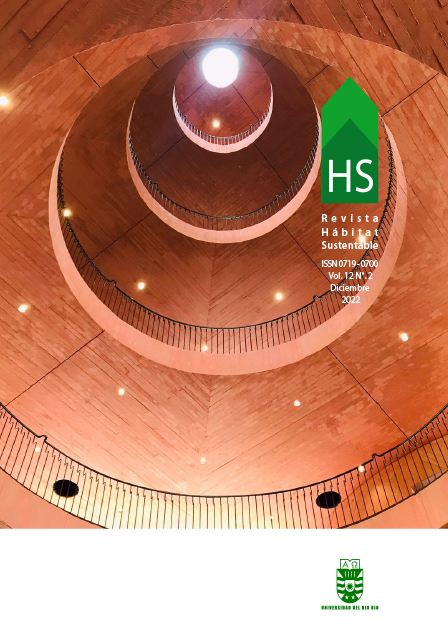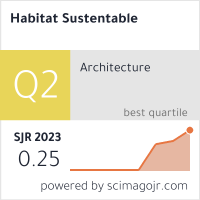Placas aislantes de EPS reciclado: factores críticos y potencialidades para la viabilidad productiva de un emprendimiento en el Partido de La Plata
DOI:
https://doi.org/10.22320/07190700.2022.12.02.02Palabras clave:
aislamiento térmico, materiales alternativos, ingeniería de la producciónResumen
Investigaciones previas han permitido desarrollar y caracterizar un material aislante a partir de descartes de poliestireno expandido (EPS) que puede utilizarse para la fabricación de placas, brindando oportunidades laborales a grupos sociales desocupados o vulnerables. Trabajando en articulación con una cooperativa de recicladores local, se determinaron los procesos productivos necesarios para su fabricación en una escala apta para su comercialización. El objetivo de esta investigación es analizar estos procesos productivos e identificar los aspectos críticos para la viabilidad de ejecución y gestión de esta tecnología. La metodología utilizada implica: i. la adecuación del producto; ii. la determinación de los insumos y recursos para su viabilidad; iii. la detección de los procesos productivos con mayor criticidad; y iv. la adecuación al caso particular de aplicación. Se obtiene un conjunto de requerimientos considerados mínimos para el desarrollo de un emprendimiento productivo. Además, se identifican en el contexto local los procesos de mayor criticidad, relativos a la separación y la obtención del EPS y su provisión continua en el tiempo. Los resultados condensan aportes para contribuir a la replicación y la sostenibilidad de esta experiencia.
Descargas
Citas
ABU-JDAYIL, B., MOURAD, A-H., HITTINI, W., HASSAN, M. Y HAMEEDI, S. (2019). Traditional, state-of-the-art and renewable thermal building insulation materials: An overview. Construction and Building Materials. 214, 709-735. DOI: https://doi.org/10.1016/j.conbuildmat.2019.04.102
ACIU C., MANEA D.L., MOLNAR L.M. Y JUMATE E. (2015). Recycling of polystyrene waste in the composition of ecological mortars. Procedia Technology, 19, (2015) 498-505. DOI: https://doi.org/10.1016/j.protcy.2015.02.071
ADITYA, L., MAHLIA, T.MI., RISMANCHI, B., NG, S.M., HASAN, M.H., METSELAAR, H.SC., MURAZA, O. Y ADITIYA, H.B. (2017). A review on insulation materials for energy conservation in buildings. Renewable and Sustainable Energy Reviews, 73, 1352-1365. DOI: https://doi.org/10.1016/j.rser.2017.02.034
BOUILLON, B. C. (Ed.). (2012). Un espacio para el desarrollo. Los mercados de vivienda en América Latina y El Caribe. New York: Banco Interamericano de Desarrollo. Recuperado de: https://publications.iadb.org/publications/spanish/document/Un-espacio-para-el-desarrollo-Los-mercados-de-vivienda-en-Am%C3%A9rica-Latina-y-el-Caribe.pdf
BUREN, N.V., DEMMERS, M., VAN DER HEIJDEN, R. WITLOX, F. (2016). Towards a Circular Economy: The Role of Dutch Logistics Industries and Governments. Sustainability, 8(7), 647. DOI: https://doi.org/10.3390/su8070647
CALÓ, J. (2009). La cadena de valor del reciclado de residuos sólidos urbanos (RSU). La dinámica socio-técnica de los procesos de reciclado en las cooperativas de recuperadores urbanos surgidas a partir de los cambios económicos, sociales y tecnológicos de la crisis del 2001. Tesis de Maestría, Universidad Nacional de Quilmes, Argentina. Recuperado de: https://biblio.unq.edu.ar/Record/1151
CARRO PAZ, R. Y GONZÁLEZ GÓMEZ, D. (2013). Diseño y selección de procesos. Colección Administración de las operaciones. Universidad Mar del Plata. Recuperado de: http://nulan.mdp.edu.ar/1613/1/08_diseno_procesos.pdf ar
CORAGGIO, J.L. (2009). Los caminos de la economía social y solidaria. Íconos, 33, 29-38. DOI: https://doi.org/10.17141/iconos.33.2009.314
DE SOUSA SANTOS, B. (2012). La universidad en el siglo XXI. Para una reforma democrática y emancipadora de la universidad. En SENESCYT (Ed.), Transformar la universidad para transformar la sociedad (pp. 139-193). La Paz: Plural Editores.
DI VIRGILIO, M.M., RODRÍGUEZ, M.C. (2018). Hábitat, vivienda y marginalidad residencial. En J.I. Piovani y A. Salvia (Coords.), La Argentina en el siglo XXI (pp. 183-220). Buenos Aires: Siglo Veintiuno.
DISSANAYAKE, D.M.K.W., JAYASINGHE, C. Y JAYASINGHE M.T.R. (2017). A comparative embodied energy analysis of a house with recycled expanded polystyrene (EPS) based foam concrete wall panels. Energy and Buildings, 135, 85-94. DOI: https://doi.org/10.1016/j.enbuild.2016.11.044
DIXIT, A., DAI PANG, S., KANG, S-H. Y MOON, J. (2019). Lightweight structural cement composites with expanded polystyrene (EPS) for enhanced thermal insulation. Cement and Concrete Composites. 102, 185-197. DOI: https://doi.org/10.1016/j.cemconcomp.2019.04.023
DURAKOVIC, B., YILDIZ, G., YAHIA, M.E. (2020). Comparative performance evaluation of conventional and renewable thermal insulation materials used in building envelops. Tehnički vjesnik, 27(1), 283-289. DOI: https://doi.org/10.17559/TV-20171228212943
ENET, M., ROMERO FERNÁNDEZ, G. Y OLIVERA GÓMEZ, R. (2008). Herramientas para pensar y crear en colectivo, en programas intersectoriales de hábitat. Córdoba: CYTED- HABYTED-RED XIV.
ESPARZA, J. (2021). Clasificación y afectación por residuos sólidos urbanos en la ciudad de La Plata, Buenos Aires, Argentina. Revista Internacional de Contaminación Ambiental, 37 (2021), 357-371. DOI: https://doi.org/10.20937/RICA.53758
FERNANDO P.L.N., JAYASINGHE M.T.R. Y JAYASINGHE, C. (2017). Structural feasibility of Expanded Polystyrene (EPS) based lightweight concrete sandwich wall panels. Construction and Building Materials, 139, 45-51. DOI: https://doi.org/10.1016/j.conbuildmat.2017.02.027
FLORES-ALÉS, V., JIMÉNEZ-BAYARRI, V. Y PÉREZ-FARGALLO, A. (2018). Influencia de la incorporación de vidrio triturado en las propiedades y el comportamiento a alta temperatura de morteros de cemento. Boletín de la Sociedad Española de Cerámica y Vidrio, 57(6), 257-265. DOI: https://doi.org/10.1016/j.bsecv.2018.03.001
HASAN, S., KHAN, S., AKHTAR, I. Y KIRMANI, S. (2021). Study of natural insulation materials and compared it with no insulation building. Materials Today: Proceedings, 46(20), 10692-10697. DOI: https://doi.org/10.1016/j.matpr.2021.01.452
INDEC (2010). Censo Nacional de Población, Hogares y Vivienda 2010. Recuperado de: https://www.indec.gob.ar/indec/web/Nivel4-CensoNacional-999-999-Censo-2010
IPA (2018). 38ª Edición de información estadística de la Industria Petroquímica y Química de la Argentina. Instituto Petroquímico Argentino. Informe. 135 pp. Recuperado de: https://noticiasutnfrn.files.wordpress.com/2020/04/anuario-ipa-2019.pdf
JANG, M., SHIM, W.J., HAN, G.M., SONG, Y.K. Y HONG, S.H. (2018). Formation of microplastics by polychaetes (Marphysa sanguinea) inhabiting expanded polystyrene marine debris. Marine Pollution Bulletin, 131 A, 365-369. DOI: https://doi.org/10.1016/j.marpolbul.2018.04.017
KIRCHHERR, J., REIKE, D. Y HEKKERT, M. (2017). Conceptualizing the circular economy: An analysis of 114 definitions. Resources, Conservation and Recycling, 127, 221-232. DOI: https://doi.org/10.1016/j.resconrec.2017.09.005
KUMAR, D., ALAM, M., ZOU, P.X.W., SANJAYAN, J.G. Y MEMON, R.A. (2020). Comparative analysis of building insulation material properties and performance. Renewable and Sustainable Energy Reviews, 131. DOI: https://doi.org/10.1016/j.rser.2020.110038
LAUKAITIS A., ŽURAUSKAS R. Y KERIEN J. (2005). The effect of foam polystyrene granules on cement composite properties. Cement and Concrete Composites, 27(1), 41-47. DOI: https://doi.org/10.1016/j.cemconcomp.2003.09.004
LI, J., SABERIAN, M. Y NGUYEN, B.T. (2018). Effect of crumb rubber on the mechanical properties of crushed recycled pavement materials. Journal of Environmental Management, 218, 291-299. DOI: https://doi.org/10.1016/j.jenvman.2018.04.062
MAAROUFI, M., BELARBI, R., ABAHRI, K. Y BENMAHIDDINE, F. (2021). Full characterization of hygrothermal, mechanical and morphological properties of a recycled expanded polystyrene-based mortar. Construction and Building Materials, 301. DOI: https://doi.org/10.1016/j.conbuildmat.2021.124310
MADARIAGA G.F.J. Y MACIA L.J. (2008). Mezclas de residuos de poliestireno expandido (EPS) conglomerados con yeso o escayola para su uso en la construcción. Informes de la Construcción, 60(509), 35-43. DOI: https://doi.org/10.3989/ic.2008.v60.i509.589
MARTEN, B. Y HICKS, A. (2018). Expanded Polystyrene Life Cycle Analysis Literature Review: An Analysis for Different Disposal Scenarios. Sustainability, 11(1) 29-35. DOI: https://doi.org/10.1089/sus.2017.0015
MENDOZA, R. H. (2000). El análisis de criticidad, una metodología para mejorar la confiabilidad operacional. Ingeniería Mecánica, 3(4), 13-19. Recuperado de: https://ingenieriamecanica.cujae.edu.cu/index.php/revistaim/article/view/364
MENG, Y., LING, T.-C. Y MO, K.H. (2018). Recycling of wastes for value-added applications in concrete blocks: An overview. Resources, Conservation and Recycling, 138, 298-312. DOI: https://doi.org/10.1016/j.resconrec.2018.07.029
OLIVEIRA, C.T., LUNA, M.M.M. Y CAMPOS, L.M.S. (2019). Understanding the Brazilian expanded polystyrene supply chain and its reverse logistics towards circular economy. Journal of Cleaner Production, 235, 562-573. DOI: https://doi.org/10.1016/j.jclepro.2019.06.319
Punto Verde Tandil Asociación Civil (20 de agosto de 2018). TelgoBIT productos. [Archivo de video]. Recuperado de: https://www.youtube.com/watch?v=DrjrU75ausk
RENABAP (19 de febrero de 2020). Barrios populares. Ministerio de Desarrollo Territorial y Hábitat. Recuperado de: https://www.argentina.gob.ar/noticias/barrios-populares
REYNOSO L. E., CARRIZO R. A. B., VIEGAS G. M. Y SAN JUAN, G. A. (2021). Characterization of an alternative thermal insulation material using recycled expanded polystyrene. Construction and Building Materials, 301. DOI: https://doi.org/10.1016/j.conbuildmat.2021.124058
SAN JUAN, G. A., VIEGAS, G. M. Y JODRA, J. I. (2018). Aislación térmica alternativa, reutilizando poliestireno expandido de descarte, orientado a las necesidades de cooperativas de reciclado. En X Congreso Regional de Tecnología en Arquitectura. La Plata, Argentina (29-31 de agosto).
STEYN, Z.C., BABAFEMI, A.J., FATAAR, H. Y COMBRINCK, R. (2021). Concrete containing waste recycled glass, plastic and rubber as sand replacement. Construction and Building Materials, 269. DOI: https://doi.org/10.1016/j.conbuildmat.2020.121242
THOMAS, H., JUÁREZ, P. Y PICABEA, F. (2015). Tecnología y desarrollo ¿Qué son las tecnologías para la Inclusión Social? Universidad Nacional de Quilmes. Reditsa. IESTC.
VIEGAS, G. M., WALSH, C. Y BARROS, M. V. (2016). Evaluación cuali-cuantitativa de aislaciones térmicas alternativas para viviendas. El caso de la agricultura familiar. Revista INVI, 31(86), 89–117. Recuperado de: https://revistainvi.uchile.cl/index.php/INVI/article/view/62719
ZHAO, J.R., ZHENG, R., TANG, J., SUN, H.J. Y WANG, J. (2022). A mini-review on building insulation materials from perspective of plastic pollution: Current issues and natural fibres as a possible solution. Journal of Hazardous Materials, 438. DOI: https://doi.org/10.1016/j.jhazmat.2022.129449
Descargas
Publicado
Cómo citar
Número
Sección
Licencia
Derechos de autor 2022 Laura Elena Reynoso, Graciela Melisa Viegas, Gustavo Alberto San Juan

Esta obra está bajo una licencia internacional Creative Commons Atribución-CompartirIgual 4.0.
El contenido de los artículos que se publican en cada número de Hábitat Sustentable, es responsabilidad exclusiva de los autores y no representan necesariamente el pensamiento ni comprometen la opinión de la Universidad del Bío-Bío.
Los autores/as conservarán sus derechos de autor y garantizarán a la revista el derecho de primera publicación de su obra, el cuál estará simultáneamente sujeto a la Licencia de Reconocimiento de Creative Commons CC BY-SA que permite a otros compartir-copiar, transformar o crear nuevo material a partir de esta obra con fines no comerciales, siempre y cuando se reconozcan la autoría y la primera publicación en esta revista, y sus nuevas creaciones estén bajo una licencia con los mismos términos.











 Programa de Información Científica/Concurso Fondos de Publicación de Revistas Científicas 2018/ Proyecto Mejoramiento de Visibilidad de Revistas UBB (Código:FP180007)
Programa de Información Científica/Concurso Fondos de Publicación de Revistas Científicas 2018/ Proyecto Mejoramiento de Visibilidad de Revistas UBB (Código:FP180007) 





